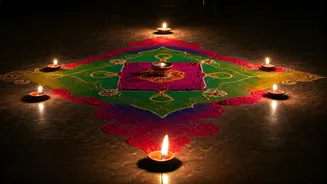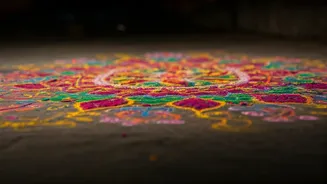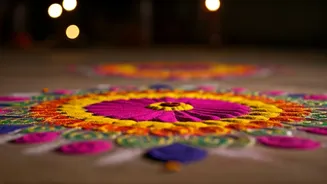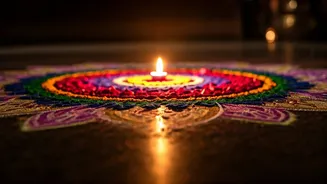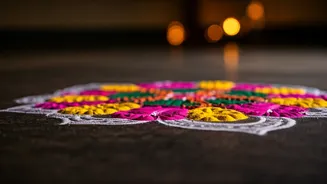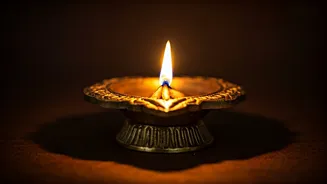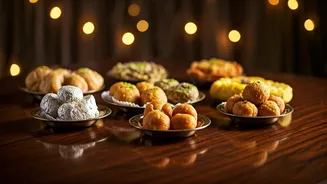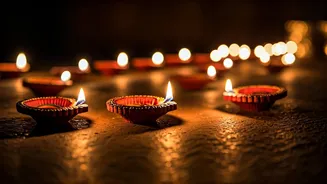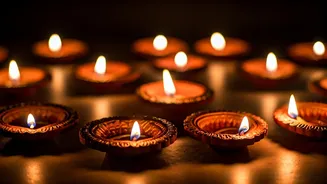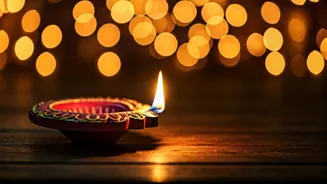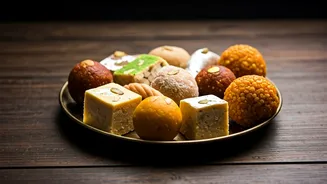Rangoli's Rich Tradition
Rangoli, a centuries-old art form, is integral to Diwali celebrations, welcoming guests and prosperity into homes. The practice involves creating intricate
patterns on the floor near entrances, using materials like colored rice, dry flour, flower petals, and colored sand. The designs often incorporate auspicious symbols such as the lotus, the swastika, and images of deities like Lakshmi and Ganesha, believed to invite divine blessings. Each region in India has unique rangoli styles; for instance, the Kolam of Tamil Nadu, the Alpana of West Bengal, and the Chowkpurana of Uttar Pradesh. Regardless of regional variations, the act of making rangoli is a shared expression of joy, creativity, and spiritual devotion, transforming ordinary spaces into festive canvases.
Flower Rangoli Delights
Flower rangoli designs are a fragrant and visually appealing way to celebrate Diwali. Using a variety of fresh flowers and petals, you can craft elaborate patterns and shapes that add a touch of natural beauty to your home. You can create a simple circular design with marigolds and rose petals or make more complex arrangements using different types of flowers and leaves. Consider incorporating diyas (oil lamps) within the flower rangoli to enhance the festive ambiance. The use of flowers not only adds color and vibrancy but also infuses the air with a delightful aroma, making the atmosphere more welcoming and celebratory. Experiment with different flower combinations and designs to create a rangoli that reflects your personal style.
Diya-Inspired Designs
Diyas, or oil lamps, are central to Diwali celebrations, symbolizing the triumph of light over darkness. Integrating diyas into your rangoli design is a way to honor this tradition. You can outline the rangoli with diyas or use their shapes as a design element. Consider creating a rangoli that resembles a large diya, using colored powders to form its flame and intricate patterns around it. Another approach is to arrange a series of small diyas within the rangoli's boundaries, lighting them to illuminate the artwork. Using the diyas as the focal point of your rangoli adds a spiritual significance to your festive decorations and enhances the overall beauty of your home during Diwali.
Geometric Patterns Magic
Geometric rangoli designs offer a modern and stylish touch to your Diwali decorations. These designs employ shapes like circles, squares, triangles, and lines to create symmetrical and eye-catching patterns. You can use compasses, rulers, and stencils to achieve precise shapes. These rangoli can be simple or intricate, depending on your skill level. Fill the geometric shapes with vibrant colors to create a visually striking effect. You can also incorporate patterns, such as spirals or concentric circles, to add complexity. The clean lines and bold colors of geometric designs can provide a contemporary twist to the traditional Diwali decorations, making them suitable for modern homes and tastes.
Peacock Theme Brilliance
The peacock, a symbol of beauty, grace, and auspiciousness, is often featured in rangoli designs. Incorporating this majestic bird into your Diwali rangoli is a beautiful way to enhance your festive decor. You can create a detailed peacock with its vibrant feathers fanned out or opt for a simplified version with just the peacock's outline. Use a wide array of colors to depict the peacock's colorful plumage, paying attention to details like eyes and patterns. Consider adding small embellishments like glitter, stones, or mirrors to enhance the visual appeal of the design. The peacock theme is very popular in Indian culture, making it a fitting choice for Diwali, a celebration of joy and beauty.
Materials and Techniques
To create the perfect rangoli, selecting the right materials and techniques is essential. Start with quality materials like rangoli powder, rice flour, or colored sand. Ensure a flat, clean surface, like the entrance area to your home. Begin by planning your design and sketching it on the floor. Start from the center of the design and work outwards to maintain symmetry. Use stencils if you're a beginner or creating intricate patterns. To make the rangoli last longer, consider using a sealant or a clear coat of varnish after completion. You can also use lights around the rangoli to enhance its visibility and beauty, especially during the evenings. By using these techniques and materials, you can create a stunning rangoli design that celebrates Diwali.
Eco-Friendly Rangoli
Embrace eco-friendly practices this Diwali by creating environmentally conscious rangoli. Instead of using artificial colors, opt for natural materials like rice flour, turmeric, and flower petals. Rice flour provides a base for your designs, while turmeric adds a vibrant yellow hue. Use different types of flowers to create a variety of colors and textures. Avoid using plastic or glitter-based products; instead, opt for organic glitter or other eco-friendly alternatives. After Diwali, you can easily dispose of the eco-friendly rangoli materials by composting them or mixing them into your garden soil. This way, you can celebrate Diwali and show your commitment to a sustainable environment.
Personalized Rangoli Ideas
Personalize your Diwali rangoli to reflect your style and creativity. Incorporate elements of your family's heritage or interests into your designs. For example, add the names of family members or incorporate symbols that are significant to your cultural background. You could also include your favorite designs or motifs, such as abstract art or mandalas. Use photographs as inspiration or create freehand designs. This personalized approach turns your rangoli into a unique piece of art that reflects your identity and celebrates the spirit of Diwali. The personal touch makes the festival even more special.
